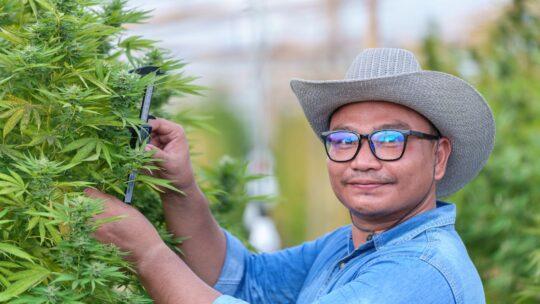Whether you’re a curious beginner with a single pot, a commercial cultivator managing thousands of plants, or simply a cannabis enthusiast eager to learn more, you’ve likely heard the term “autoflower seeds.” But what are autoflower seeds, and why are they generating so much buzz?
In simple terms, these are special seeds that grow into plants that flower automatically, without needing the change in light cycles that traditional cannabis plants require. This unique characteristic makes autoflower seeds a game-changer, simplifying the growing process and opening up new possibilities for growers everywhere.
What Does Autoflower Mean? Understanding the Basics
So, what does autoflower mean? The term itself is a straightforward clue: it means “automatic flowering.” Unlike traditional cannabis varieties, known as photoperiod strains, which rely on specific light-dark cycles to trigger their flowering stage, an autoflower marijuana plant flowers based on its age.
Typically, after just 2 to 4 weeks of vegetative growth, an autoflower plant will automatically begin to produce buds, regardless of how many hours of light it receives each day. This is a fundamental departure from the way most cannabis plants have been cultivated for centuries.
For those new to growing, understanding what is autoflower is key to appreciating its simplicity. With photoperiod strains, growers must meticulously control the light schedule, typically providing 18-24 hours of light during the vegetative stage and then switching to a 12-hours-on, 12-hours-off schedule to induce flowering. This often requires separate growing spaces or complex lighting setups. In contrast, an autoflower weed plant eliminates this complexity.
You can keep your lights on for 18, 20, or even 24 hours a day from seed to harvest, and the plant will still flower on its own schedule. This hands-off approach is what makes autoflower cannabis so appealing, especially to those who want a more streamlined, forgiving, and low-maintenance growing experience.
History and Genetics of Autoflowering Cannabis
The story of autoflowering cannabis is a tale of adaptation and discovery. Its roots trace back to a unique subspecies of cannabis known as Cannabis ruderalis. Native to the harsh climates of Russia, Central Europe, and Siberia, ruderalis evolved to survive in regions with short summers and long daylight hours. Unlike its indica and sativa cousins, which evolved closer to the equator and rely on changing light cycles to time their reproduction, ruderalis had to be quick.
It adapted to flower based on age, ensuring it could produce seeds before the first frost. This remarkable trait was first officially identified by Russian botanist Janischewski in 1924.
For many years, Cannabis ruderalis was largely overlooked by the cannabis community. It was small, produced low yields, and had very low levels of THC, the primary psychoactive compound in cannabis.
However, in the early 2000s, a breeder known as The Joint Doctor had a revolutionary idea. He began crossbreeding Cannabis ruderalis with more potent indica and sativa strains. The result was the legendary Lowryder, the first commercially successful autoflower cannabis strain.
While these early strains were not particularly potent, they proved that the autoflowering trait could be passed on. This breakthrough sparked a revolution in cannabis breeding.
Today, after years of refinement, modern what is autoflower seeds have been developed to produce plants that are not only fast and easy to grow but also boast impressive potency, with some strains reaching THC levels of 25% or more, rivaling their photoperiod counterparts.
How Autoflower Seeds Differ from Photoperiod Seeds
When choosing cannabis seeds, the most significant decision a grower makes is between autoflower seeds and photoperiod seeds. Understanding the differences is crucial for a successful harvest.
The most fundamental distinction, as we’ve discussed, is the flowering trigger. What are autoflowering seeds if not plants that flower with age? In contrast, photoperiod strains are dependent on the light cycle. They require a shift to 12 hours of darkness to begin flowering, mimicking the changing seasons outdoors.
This difference has several practical implications for growers:
Timeline
Autoflowers are the sprinters of the cannabis world. From seed to harvest, an autoflower weed plant is typically ready in just 8 to 12 weeks. Photoperiod strains, on the other hand, have a much longer and more variable timeline, often taking anywhere from 10 to 32 weeks, depending on the strain and the length of the vegetative period, which the grower controls.
Size
Autoflowers are known for their compact, discreet size. They typically grow to a height of 40-100 cm, making them ideal for growers with limited space, such as those using a small tent, a balcony, or a stealthy corner of a garden. Photoperiod plants, if left to vegetate for a long time, can become enormous, which can be a disadvantage for home growers.
Control
With photoperiod strains, the grower has complete control over the size of the plant. By extending the vegetative period, you can grow massive plants with potentially huge yields.
Autoflowers, however, are on a fixed schedule. Once they start their 2-4 week vegetative phase, there’s no turning back. This lack of control can be a drawback for experienced growers who want to maximize their plants’ size and yield.
Light Management
Growing autoflowering cannabis is far simpler when it comes to lighting. You can use a single light schedule (e.g., 18/6, 20/4, or even 24/0) for the entire life of the plant. Photoperiod strains require a strict, uninterrupted 12-hour dark period to flower, which means growers need to be vigilant about light leaks that could stress the plants or revert them to the vegetative stage.
Key Benefits of Autoflower Marijuana for Growers
The rise in popularity of autoflower marijuana isn’t just a trend; it’s a testament to the significant advantages these plants offer to a wide range of growers. From beginners to seasoned experts, the benefits are hard to ignore. Here are some of the key reasons why so many are turning to autoflower seeds:
Faster Harvests
This is perhaps the most celebrated benefit. With a life cycle of just 8-12 weeks, you can get from seed to harvest in record time. This means you don’t have to wait as long to enjoy the fruits of your labor.
Multiple Harvests Per Season
For outdoor growers, the speed of autoflowering cannabis allows for multiple harvests in a single growing season. You can plant a crop in the spring and harvest it in the summer, then plant another for an autumn harvest. In warmer climates, you might even squeeze in a third or fourth.
Beginner-Friendly
If you’re new to growing, autoflowers are your best friend. Their resilience, forgiving nature, and the lack of need to manage light cycles make them incredibly easy to grow. They are a great way to learn the ropes of cannabis cultivation without the steep learning curve of photoperiod strains.
Space Efficiency
The compact size of an autoflower weed plant is a huge advantage for those with limited space. You can easily grow them in small tents, closets, or on a balcony without them taking over. This makes them perfect for urban and stealth growers.
Light Pollution Resistance
Outdoor growers in urban or suburban areas often struggle with light pollution from streetlights, which can disrupt the flowering cycle of photoperiod plants. Since autoflower cannabis flowers based on age, it is completely unaffected by light pollution.
Cost Savings
While the initial investment in weed seeds might be similar, the shorter growing cycle and simpler light requirements can lead to significant cost savings on electricity, nutrients, and other resources.
Stealth Growing
The small stature of autoflowers makes them ideal for discreet growing. If you want to keep your cultivation activities private, these compact plants are much easier to conceal than their towering photoperiod cousins.
Common Myths and Misconceptions About Autoflowering Cannabis
Despite their growing popularity, there are still many myths and misconceptions surrounding autoflowering cannabis. Let’s clear the air and separate fact from fiction.
Myths
- Autoflowers are not potent – This is perhaps the most persistent myth, and it’s completely outdated. While the early autoflower cannabis strains were indeed low in THC, modern breeding has changed the game.
Today’s what are autoflower seeds can produce cannabis that is just as potent as photoperiod strains, with some varieties boasting THC levels of 25% or more. There are also high-CBD, low-THC autoflowers for those seeking therapeutic benefits without the intense high.
- Autoflowers have low yields – Again, this was true of the original Lowryder, but it’s no longer the case. While a single autoflower weed plant may not yield as much as a massive photoperiod plant that has been vegetated for months, the speed of autoflowers allows for more harvests per year. This means that, over the course of a year, you can actually achieve a higher total yield with autoflowers.
- You can’t clone autoflowers – This one is actually true. Because autoflowers are on a fixed timeline from the moment they sprout, a clone taken from a mother plant will be the same age as the mother. This means it will start flowering at the same time, resulting in a tiny, unproductive plant. For this reason, autoflower seeds are the only way to grow autoflowering plants.
- Autoflowers are only for beginners – While they are an excellent choice for beginners, many experienced and commercial growers are embracing autoflowering cannabis. The speed, efficiency, and resilience of these plants offer advantages that appeal to growers of all skill levels. They are a valuable tool in any cultivator’s arsenal.
Growing Guide for Autoflowering Seeds
Growing autoflower seeds is a rewarding experience, and with a few basic guidelines, you can achieve a fantastic harvest. Here’s a simple guide to get you started.
Light Requirements
One of the biggest advantages of growing an autoflower weed plant is the simple light schedule. Unlike photoperiod strains, you don’t need to change the light cycle to induce flowering. For the best results, most growers recommend providing 18 to 24 hours of light per day throughout the entire life of the plant.
A common choice is an 18/6 schedule (18 hours of light, 6 hours of darkness), but some growers have great success with a 20/4 or even a 24/0 schedule. The key is to provide plenty of light to fuel the plant’s rapid growth.
Soil and Nutrients
When it comes to soil, what are autoflowering seeds looking for? They prefer a light, airy, and well-draining medium. A pre-made potting mix designed for cannabis is a good choice, or you can create your own by mixing peat moss, compost, perlite, and vermiculite.
In terms of nutrients, autoflowers are generally lighter feeders than photoperiod strains. It’s best to start with a lower dose of nutrients and gradually increase it as the plant grows. Be careful not to overfeed, as this can lead to nutrient burn and stunt the plant’s growth. [See our growing guide] for more detailed information on nutrient schedules.
Timeline and Stages
The life of an autoflowering cannabis plant is a quick and exciting journey. Here’s a typical timeline:
Germination (1-3 days)
This is where it all begins. You can germinate your autoflower seeds using the paper towel method, by planting them directly in the soil, or by soaking them in water.
Vegetative Stage (2-4 weeks)
During this short period, the plant will focus on growing leaves and stems. You’ll see rapid growth as it establishes its root system and prepares for flowering.
Flowering Stage (6-8 weeks)
This is when the magic happens. The plant will automatically start to produce buds, and you’ll begin to see the familiar white pistils emerge. The buds will continue to fatten up over the next several weeks, developing their aroma and potency.
Harvest
You’ll know it’s time to harvest when the trichomes (the tiny, crystal-like glands on the buds) have turned from clear to a milky white or amber color. You can use a magnifying glass or jeweler’s loupe to get a closer look.
Who Should Grow Autoflower Seeds and Why?
So, who is the ideal candidate for growing autoflower seeds? The truth is, these versatile plants have something to offer almost everyone.
Beginner Growers:
If you’re just starting, autoflower marijuana is the perfect choice. The forgiving nature of these plants, combined with their simple light requirements and resistance to common mistakes, makes for a much smoother learning curve.
Commercial Cultivators
For commercial growers, time is money. The fast turnaround of autoflowering cannabis allows for more harvests per year, which can lead to a significant increase in profits. They are also a great option for perpetual harvest setups.
Space-Limited Growers
If you’re working with a small tent, a closet, or a balcony, the compact size of an auto flower weed plant is a major advantage. You can produce a respectable yield without needing a large growing area.
Outdoor Growers
The resilience and speed of autoflowers make them an excellent choice for outdoor cultivation. They can handle less-than-ideal weather conditions and can be harvested before the autumn frost sets in.
Stealth Growers
If you need to keep your garden discreet, the small stature of autoflower cannabis is a huge asset. They are much easier to conceal than their larger photoperiod counterparts.
Frequently Asked Questions
Let’s answer some of the most common questions about what autoflower seeds are.
Do autoflowers need specific light cycles?
No, they don’t. This is one of their biggest advantages. An autoflower cannabis plant will flower automatically based on its age, regardless of the light schedule. However, for the best results, it’s recommended to provide 18-24 hours of light per day.
Can you clone autoflowering plants?
Technically, you can take a cutting from an autoflower, but it’s not recommended. The clone will be the same age as the mother plant and will start to flower at the same time, resulting in a very small, unproductive plant. It’s best to grow autoflowers from seed.
Are autoflowers as potent as photoperiod strains?
Yes, they can be. While early autoflowers were not very potent, modern breeding has produced autoflower marijuana strains that are just as strong as their photoperiod counterparts, with some reaching THC levels of 25% or more.
How many harvests per year are possible?
With a life cycle of just 8-12 weeks, you can easily achieve multiple harvests per year. Outdoor growers can get 2-3 harvests in a single season, while indoor growers can have a perpetual harvest, with new plants starting every few weeks.
What’s the average yield?
The yield of an autoflower weed plant can vary depending on the strain, the growing conditions, and the skill of the grower. However, with good care, you can expect to harvest anywhere from 30 to 150 grams per plant.
Conclusion
Now that you have a thorough understanding of what autoflower seeds are, you can see why they have become such a popular choice for growers of all levels. From their fascinating history and unique genetics to their incredible speed, simplicity, and versatility, autoflower seeds offer a host of benefits that are hard to resist.
Whether you’re a beginner looking for an easy introduction to cannabis cultivation or an experienced grower seeking a faster turnaround, autoflowering cannabis is a fantastic option.
We encourage you to continue your research, explore the wide variety of autoflower strains available, and perhaps even try growing them yourself. With a little care and attention, you’ll be amazed at what these remarkable plants can do. Happy growing!



















